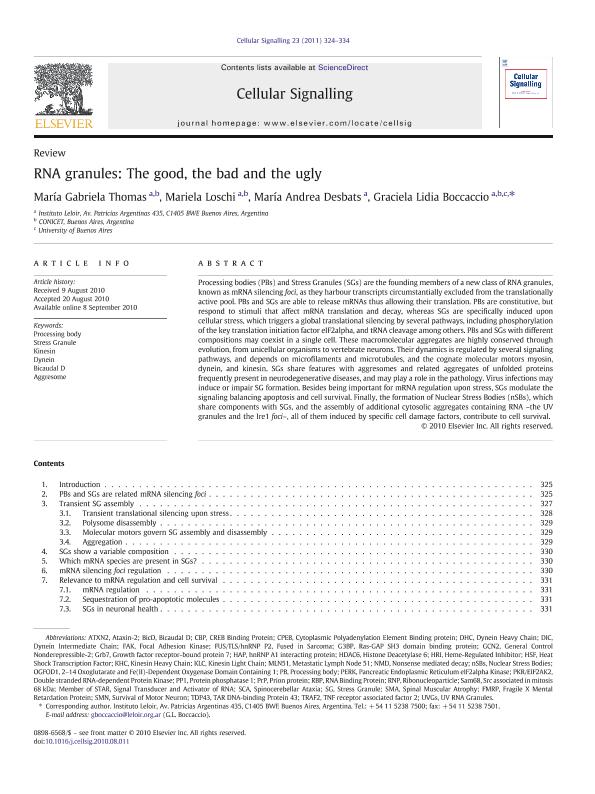Mostrar el registro sencillo del ítem
dc.contributor.author
Thomas, Maria Gabriela

dc.contributor.author
Loschi, Mariela

dc.contributor.author
Desbats, Maria Andrea

dc.contributor.author
Boccaccio, Graciela Lidia

dc.date.available
2017-02-09T21:45:32Z
dc.date.issued
2011
dc.identifier.citation
Thomas, Maria Gabriela; Loschi, Mariela; Desbats, Maria Andrea; Boccaccio, Graciela Lidia; RNA granules: The good, the bad and the ugly; Elsevier; Cellular Signalling; 23; 2; 2011; 324-334
dc.identifier.issn
0898-6568
dc.identifier.uri
http://hdl.handle.net/11336/12811
dc.description.abstract
Processing bodies (PBs) and Stress Granules (SGs) are the founding members of a new class of RNA granules, known as mRNA silencing foci, as they harbour transcripts circumstantially excluded from the translationally active pool. PBs and SGs are able to release mRNAs thus allowing their translation. PBs are constitutive, but respond to stimuli that affect mRNA translation and decay, whereas SGs are specifically induced upon cellular stress, which triggers a global translational silencing by several pathways, including phosphorylation of the key translation initiation factor eIF2alpha, and tRNA cleavage among others. PBs and SGs with different compositions may coexist in a single cell. These macromolecular aggregates are highly conserved through evolution, from unicellular organisms to vertebrate neurons. Their dynamics is regulated by several signaling pathways, and depends on microfilaments and microtubules, and the cognate molecular motors myosin, dynein, and kinesin. SGs share features with aggresomes and related aggregates of unfolded proteins frequently present in neurodegenerative diseases, and may play a role in the pathology. Virus infections may induce or impair SG formation. Besides being important for mRNA regulation upon stress, SGs modulate the signaling balancing apoptosis and cell survival. Finally, the formation of Nuclear Stress Bodies (nSBs), which share components with SGs, and the assembly of additional cytosolic aggregates containing RNA -the UV granules and the Ire1 foci-, all of them induced by specific cell damage factors, contribute to cell survival.
dc.format
application/pdf
dc.language.iso
eng
dc.publisher
Elsevier

dc.rights
info:eu-repo/semantics/openAccess
dc.rights.uri
https://creativecommons.org/licenses/by-nc-nd/2.5/ar/
dc.subject
Stress Granule
dc.subject
P Bodies
dc.subject
Neuron
dc.subject.classification
Bioquímica y Biología Molecular

dc.subject.classification
Ciencias Biológicas

dc.subject.classification
CIENCIAS NATURALES Y EXACTAS

dc.title
RNA granules: The good, the bad and the ugly
dc.type
info:eu-repo/semantics/article
dc.type
info:ar-repo/semantics/artículo
dc.type
info:eu-repo/semantics/publishedVersion
dc.date.updated
2017-02-07T13:51:58Z
dc.journal.volume
23
dc.journal.number
2
dc.journal.pagination
324-334
dc.journal.pais
Países Bajos

dc.journal.ciudad
Amsterdam
dc.description.fil
Fil: Thomas, Maria Gabriela. Fundación Instituto Leloir; Argentina. Consejo Nacional de Investigaciones Científicas y Técnicas. Oficina de Coordinación Administrativa Parque Centenario. Instituto de Investigaciones Bioquimicas de Buenos Aires; Argentina
dc.description.fil
Fil: Loschi, Mariela. Fundación Instituto Leloir; Argentina. Consejo Nacional de Investigaciones Científicas y Técnicas. Oficina de Coordinación Administrativa Parque Centenario. Instituto de Investigaciones Bioquimicas de Buenos Aires; Argentina
dc.description.fil
Fil: Desbats, Maria Andrea. Fundación Instituto Leloir; Argentina. Consejo Nacional de Investigaciones Científicas y Técnicas. Oficina de Coordinación Administrativa Parque Centenario. Instituto de Investigaciones Bioquimicas de Buenos Aires; Argentina
dc.description.fil
Fil: Boccaccio, Graciela Lidia. Consejo Nacional de Investigaciones Científicas y Técnicas. Oficina de Coordinación Administrativa Parque Centenario. Instituto de Investigaciones Bioquimicas de Buenos Aires; Argentina. Fundación Instituto Leloir; Argentina
dc.journal.title
Cellular Signalling

dc.relation.alternativeid
info:eu-repo/semantics/altIdentifier/url/http://www.sciencedirect.com/science/article/pii/S089865681000238X
dc.relation.alternativeid
info:eu-repo/semantics/altIdentifier/doi/http://dx.doi.org/10.1016/j.cellsig.2010.08.011
Archivos asociados
